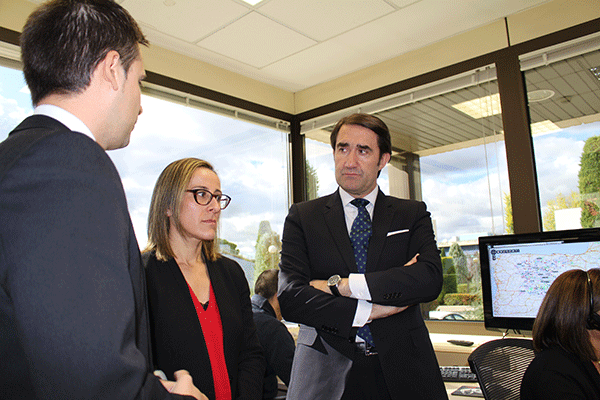The Regional Council of Galicia shows interest in GMV’s demand-response transport system

Galicia is a Spanish region with a huge public-transport demand. There are 143 scheduled transport services clocking up 50 million kilometers a year and attending 7500 bus stops. Add school buses to the mix, with 3900 daily routes and 23,500 pick-up points, and the figures are even more striking.
Galicia’s regional authority, the Xunta, is currently immersed in a transport modernization and reorganization plan. On 7 November Valladolid hosted a meeting of the working teams of not only the Galician regional government, headed by the Regional Minister of Infrastructure and Housing, Ethel María Vázquez, but also of the neighboring region of Castilla y León, headed by the Regional Minister of Public Works and the Environment, Juan Carlos Suárez Quiñones. The purpose of the meeting was to study the demand-response transport model set up in the latter region in 2004 to meet the variable transport needs of scattered populations in rural areas.
Both regional ministers visited the Valladolid site of GMV, a company that intervened in the design and development of the system that is currently responsible for the telematic management of this trailblazing system in Spain.
Castilla y León’s demand-response system is a groundbreaking system within Europe, enabling towns and villages to be connected à la carte, tailoring the supply to the demand. It currently includes 810 routes serving over one million inhabitants of 3557 towns and villages. Since its implementation the service has chalked up a total ridership of over about 3 million, serving over 105 zones within the region. The demand-response model avoids the emission of 10,000 tons of CO2 and achieves a total fuel saving of 2.5 million liters.
The visitors were received by Miguel Ángel Martínez, General Manager of GMV Intelligent Transportation Systems, Fermín Catalán, deputy General Manager, and the rest of the company’s executives. After the initial welcome, Miguel Ángel Martínez ran through GMV’s main business lines, focusing particularly on its transport activities. This was followed by a presentation of the demand-response system by Óscar Casado, Head of System Engineering, Development and Integration, who gave a detailed explanation of the system (telephone attention center, real-time service map …). Finally the guests visited the production area, where they found about GMV’s other transport projects, including the advanced fleet management system GMV is developing for Galicia and the equipment GMV is supplying for ticketing systems in different countries.
During the visit Vázquez announced that the first phase of the demand-response transport system will be set up in Galicia in August 2017 to be completed by the end of 2019, with the overall remit of providing Galicia’s rural areas with an "efficient and top-quality" transport service. The Minister of Public Works and the Environment, for his part, pointed out that Castilla y León’s demand-response system has attracted interest not only from Spain’s regional authorities but also countries like Hungary, Portugal and Chile.
Both minsters showed a keen interest in the workings of the demand-response transport system, including the fare structure, system architecture, service information and also the possibility of drawing up reports and statistics.
In Europe GMV has also set up a similar system in Portugal, in Molina de Aragón (Guadalajara) and it has also been built into the ITS developed for the Polish city of Szczecin, bearing out the efficacy and economic feasibility of this public-transport model in the rural world.